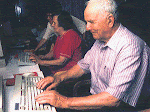 |
| Healthcare Provider and guy who knows CPR attend to referred chiropractic patient |
"I learned about the signs and symptoms of heart attacks during physiology classes my first year of chiropractic college but this is the first time I actually saw one," Grimes explained. "I guess it's like they say. When push comes to shove, the reading kicks in."
Chiropractors, although most commonly thought of as doctors of the back and spine, are educated as primary care practitioners and boast some of the most stringent educational requirements of the health care professions. After four years of pre-medical college education, which includes classes in biology, both inorganic and organic chemistry, physics and psychology, future chiropractors must then make it through the highly selective chiropractic college admissions process.
Remington Abernathy III, President and Head Cashier of Land's End Chiropractic College and Outlet Store in Dodgeville, Wisconsin told us that chiropractic training is comparable to a conventional four year medical education. And like most medical schools, they hardly ever admit convicted felons.
Remington Abernathy III, President and Head Cashier of Land's End Chiropractic College and Outlet Store in Dodgeville, Wisconsin told us that chiropractic training is comparable to a conventional four year medical education. And like most medical schools, they hardly ever admit convicted felons.
"I'm not surprised that Dr. Gimes was able to make an appropriate referral. Chiropractic students receive 4,200 hours of classroom, laboratory and clinical training in "orthopedics, neurology, physiology, human anatomy, clinical diagnosis including laboratory procedures, diagnostic imaging, exercise, nutrition, rehabilitation and more. They also get a box of bones for practice at home and 80% off select Great Courses lectures."Some have criticized the chiropractic profession's transition into the role of primary care practitioner, pointing out that for the truly sick patient a visit to the chiropractor is at best an unnecessary step and at worst a dangerous delay. There are also concerns that chiropractic education and experience may be insufficient to allow recognition of the more subtle presentations of serious illness or a broad enough working knowledge of human pathophysiology. But recovering heart attack victim Surge Kaserman isn't paying any attention to cynics and naysayers. "I don't need that negativity in my life. If Dr. Grimes hadn't been there to refer me to the appropriate healthcare provider, I might not be here today."

No comments:
Post a Comment